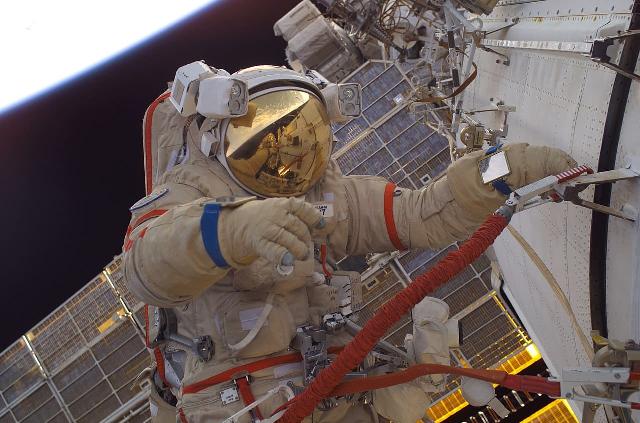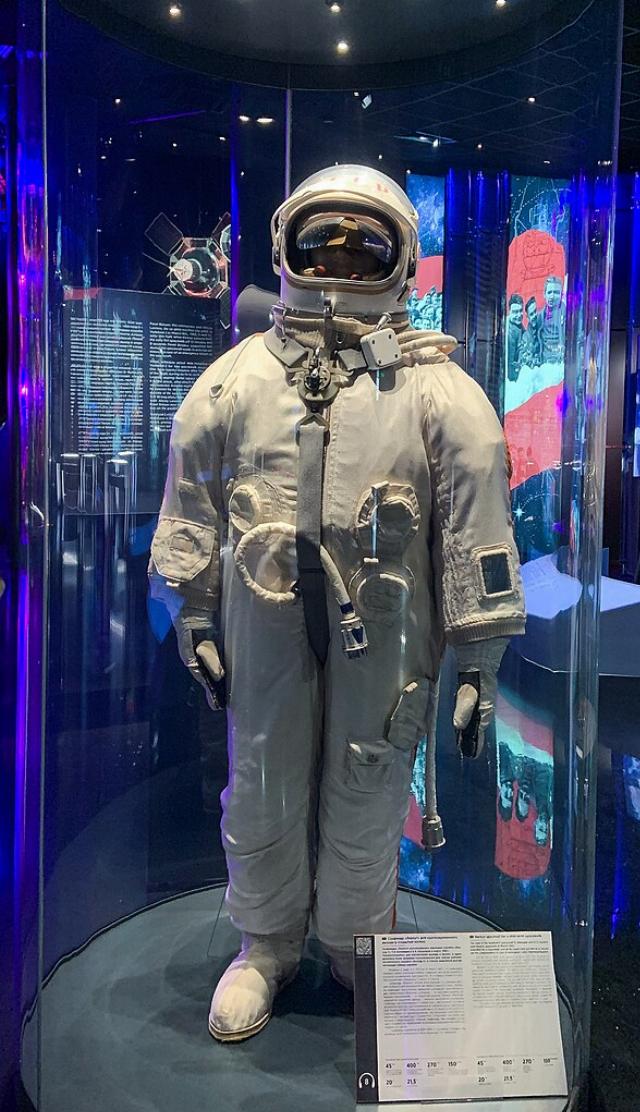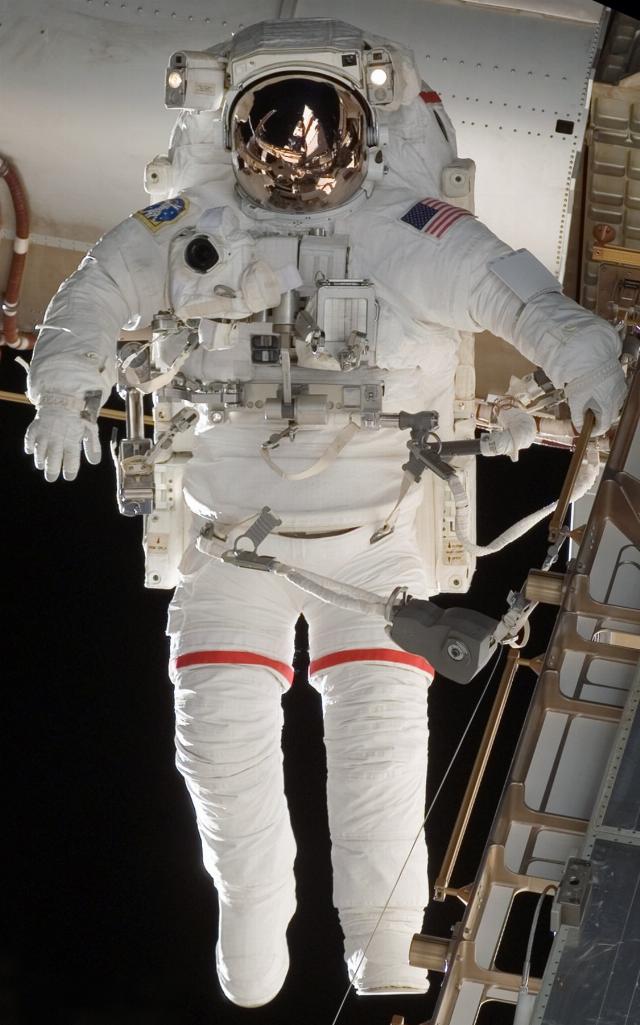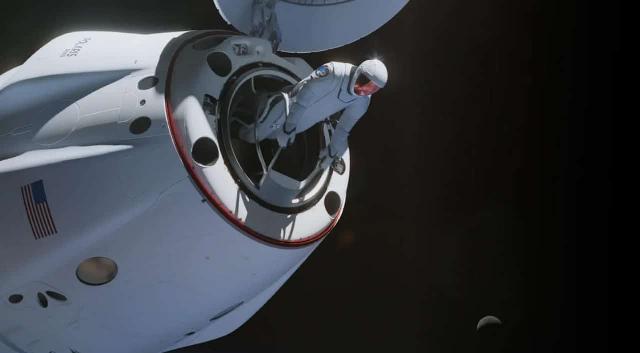When SpaceX showed the spacesuit for the 2024 Polaris Dawn summer mission, many reacted almost enthusiastically. Of course: the new extravehicular spacesuit for such a mission looks stylish and, most importantly, not bulky. But for experts, the appearance of the equipment caused serious concern. Is Musk really going to land people on the Moon and Mars in spacesuits without an oxygen tank? Is this a revolution in spacesuit engineering or the most dangerous experiment on astronauts in history? In the 1960s, due to suboptimal costumes, the United States had already lost three people in a ground flight rehearsal. Will SpaceX be next in this sad relay race?
An extravehicular space suit is essentially a single—seat spacecraft (sometimes even with its own microdrive). Unsurprisingly, they weigh over 110 kilograms and cost tens of millions of dollars or more. Therefore, SpaceX will inevitably have to make its own, and massively — thousands of pieces and much cheaper than existing ones.
The significance of this intention for the future of humanity cannot be overestimated. Space exploration is basically impossible without extravehicular spacesuits. Contrary to the stories often repeated in the media about the extreme success of automata in exploring other worlds, in practice the best extraterrestrial automata on Mars or the Moon travel [...] at most a hundred meters a day. And they can dig 45 centimeters deep — like children in a sandbox .
The SpaceX video shows the new spacesuit from the advantageous side. But ignores a lot of questions that arise from specialists / © YouTube, SpaceX
According to modern data, there may well be life on Mars and even the Moon — but at depths from a meter or even, in the case of Selena, from hundreds of meters. Automata, in principle, cannot get there in any foreseeable future. Man, on the contrary, is extremely versatile. Back in the 1970s, he showed the ability to move on another celestial body for many kilometers a day, dig and navigate through difficult terrain, where planetary rovers stably get stuck .
That is why only six manned missions to the Moon gave Earth science much more than literally dozens of years of human flights to orbital stations: astronauts took on Selenium those samples of local rocks that were required and from where they were required, and in quantities orders of magnitude larger than automata can.
But all this is possible if one important condition is met: a workable spacesuit. The first one was described well by Tsiolkovsky in the novella "Beyond the Earth" in 1918. Unfortunately, modern spacesuits lag far behind the descriptions of man in 1918. And this has created and is creating very big problems in space exploration.
Why are the existing spacesuits not suitable for the exploration of the Moon and Mars?
Firstly, existing spacesuits — if you do not take the Russian Orlan, which is not threatened by flights to the Moon or Mars in the foreseeable future due to the position of Roscosmos - are extremely inconvenient or extremely unsafe. Moreover, "extremely" is not an exaggeration.
NASA's Extravehicular Mobility Unit, an extravehicular spacesuit, has been in use since the days of the shuttles and by now only 11 pieces have been preserved (the rest were lost in disasters). The USA repairs, patches and reshoots them, but products from the 1980s really need to be replaced.

It would seem that it is possible to land on the Moon in the Orlan, since its Soviet ancestor was also developed just for landing on it. Therefore, it has 0.4 atmospheres inside (you do not need to prepare for an exit for hours, 30 minutes will be enough), and a special "cuirass" compensates for inflating the suit from the inside at such pressure. The Orlan also has a large margin of safety (three times the nominal pressure, the American spacesuits have twice). Also, only one person can put it on, because there is a door on the back of the spacesuit where the astronaut passes entirely (American spacesuits are put on in parts, it is difficult to put them on alone). But all these advantages are outweighed by one minus: the "Eagles" are Russian, which means that the United States will not take them to the Moon. Roscosmos does not seek to go there itself this decade
Image source: Wikimedia Commons
And not only because of physical wear and tear. They use a pressure of 0.3 atmospheres — like on Mount Everest. You can't breathe ordinary air at this pressure, so there's pure oxygen there. But if a person gets into a spacesuit with 0.3 atmospheres immediately after 1 atmosphere on the ISS, then he will have a caisson disease. To avoid it, it is necessary to "expel" excess nitrogen from the blood. To do this, the astronaut sits on an exercise bike before going out and begins to breathe pure oxygen.
And he breathes it, pedaling, for four long, monotonous hours. After that, he goes out to fix something or install it in outer space. Overcoming the overpressure of a spacesuit is a very difficult task. In a typical exit at 2-3 hours, a person in it loses 2-3 kilograms, like a tankman on a T-34 during the Great Patriotic War in 2-3 hours of tank combat. Needless to say, four—hour bike races before such jobs are a serious burden. And even a simple four-hour wait, for that matter. All of this more or less works on the ISS, but…
SpaceX was not founded by Elon Musk to fly to the ISS. Its creator — like NASA in the Artemis program — needs other celestial bodies. There, unlike the ISS, there is some kind of gravity. And also a lot of hard physical work for astronauts. Walking on the Moon for kilometers in hundredweight spacesuits, collecting samples, beating stones with geological hammers, and eventually drilling.
A four—hour bike race before each such exit is a kettlebell on the leg. It would be good to make other spacesuits, such as the Russian "Eagles", where it is enough to breathe oxygen for half an hour, not four.
But there are big problems with the development of new spacesuits in the USA. In 2023, NASA began to look for a replacement for its own, worn out over forty years. However, the Agency did not even plan to make new ones: in the 2010s, it tried to develop them itself, and realized that it would be too expensive.
A fresh idea came up: to rent them, it would be cheaper. But even to pay for the lease, NASA was forced to reserve $ 3.5 billion . For less money, there were no hunters to develop them.
The AL-7 spacesuits for the Moon were designed in the steam of the lunar race, which made their knees bend badly. American astronauts were forced to jump on the slopes on the Moon like bunnies, otherwise the movement was inconvenient. This example illustrates well the complexity of designing extravehicular spacesuits / © YouTube, NASA
3.5 billion dollars is a lot. For comparison, NASA paid SpaceX only $ 2.6 billion to ensure the delivery of astronauts to the ISS. That is, it can be significantly cheaper to fly into space than to get new spacesuits to work in it.
SpaceX has explicitly stated that it needs hundreds and thousands of spacesuits in the near future. If they were created according to the principles of NASA, they would cost trillions of dollars and would simply not be affordable for private space companies.
In other words, Elon Musk's company wants to stage a technical revolution again, as it once did with the landing of Falcons on the tail. But this time there are even greater risks with it than before.
Into space without an oxygen tank
In May 2024, a group of private astronauts led by Jared Azeikman (we wrote about it here ) showed the general appearance of an extravehicular spacesuit from SpaceX. A spacesuit in which astronauts plan to go into space during Polaris Dawn and test the ability to work in it for hours.
And this video causes something between anxiety and shock. The fact is that the spacesuit shown on it looks exactly the same as the SpaceX in—ship spacesuit on which astronauts fly to the ISS - that, of course, is not designed to work in a vacuum. You can't even get far away from the chair in it: the air enters there through a flexible tube connected to the life support system of the Crew Dragon spacecraft.
SpaceX's extravehicular spacesuit also does not have an oxygen tank yet and depends on a flexible tube connecting to the spacesuit in the area of the astronaut's hip. It is not easy to say what will happen if it loses its tightness or "collapses" from the movements of the astronaut.
Experts, however, are not even concerned about SpaceX's lack of an oxygen tank on its spacesuit. Contrary to jokes from Western social networks, the company is not going to land people on the Moon and Mars with a flexible tube coming from the ship. It is clear that over time, the astronaut's life support system will still be completed there.
The crew of Crew Dragon in the future Polaris Down mission will be led by Jared Isaakman, a former pilot who performed at an air show and set a world record for circumnavigating the world in a light jet aircraft
Image source: SpaceX
But the design shown suggests a lot of other unpleasant questions. For example, an extravehicular spacesuit of such outlines cannot have a place for a diaper. And indeed, he is not in the new spacesuit. How will things be in Polaris Dawn if someone wants to go to the toilet? No way: you will have to endure for hours. It will not even be possible to return to the ship, because there is no airlock on Crew Dragon, and all the air will be released from it to get people out of it into space. You can't use the on-board toilet in a vacuum.
Nikolai Moiseev, who worked in Russia in the past (the Orlan glove), and is now developing spacesuits in the United States, noted* a number of other bottlenecks of the shown spacesuit:
"There are no shoulder joints, only small diameter shoulder bearings. There are no bearings for the upper arm. There are no carpal joints with two degrees of freedom. A lot is missing. A very simple spacesuit "from the 1960s" with an "umbilical cord" [life support reaching for the ship]. The shoulder bearings [visible on it] are painful for people in a spacesuit when landing. Look at the history of the development of Orion MACES or the history of the development of Russian in-ship spacesuits. I don't think they [SpaceX] certify this one for high G-forces."

The Berkut spacesuit, in which Leonov once made his first spacewalk. In this design, as with SpaceX, the spacesuit itself and the backpack with the life support system are separate. With a small weight of 41 kilograms, the Berkut had an extremely limited range of motion (a completely soft spacesuit), which forced it to be abandoned after Leonov's first exit. It's strange to see similar approaches in the 2020s
Image source: Wikimedia Commons
If a spacesuit cannot be worn at high overloads, then it is impossible to be in it during landing — or astronauts, literally, will be hurt: shoulder bearings will press into their hands during landing, soft tissue injuries are almost inevitable. But according to the data available today, there are no separate in-ship spacesuits in the Polaris Dawn mission (there is not enough space): Both on takeoff and landing, all four people will be sitting in extravehicular spacesuits.
All this is very similar to some kind of experiment: they say, let's see how big bruises the bearings will leave on people's shoulders. And let's see how uncomfortable it is to walk with an umbilical cord in outer space. And let's see if it's possible to work in space for two hours (plus an hour to relieve pressure before exiting) without a diaper. Actually, the trajectory of the Crew Dragon ship during the Polaris Down mission is the same "experimental": the ship will pass through the radiation belts of the Earth to see what level of radiation will be inside the ship.
Bill Ayrey, author of the book on the development of American lunar spacesuits "Lunar Outfitters, Making the Apollo Space Suit", in connection with Moiseev's theses, summarized the concerns of experts about the SpaceX spacesuit as follows:
"Nikolai has more experience in the development of spacesuits than all the "spacesuit engineers" from SpaceX combined. SpaceX prides itself on failing, on the basis of which it learns and redesigns its developments. But there is no room for failure in extravehicular spacesuits for outer space."
It's not the spacesuit that ruins the astronaut, it's the haste of his designer that ruins the astronaut.
To understand to what extent Airy is right, it is worth remembering the deaths of three American astronauts during the rehearsal of the first Apollo mission. Why did they die?
It's easy to guess: four-hour bike races before going into space are unacceptable for flights to the Moon not only in our era, but also in the 1960s. Therefore, the developers of the Apollo missions did not even plan to mock the astronauts like that. Instead, they sent them to Selena in ships and lunar modules with an atmosphere "like in a spacesuit" — with an internal pressure of 0.3 earth's, which made the air inside it consist of almost pure oxygen.
Anyone who has worked with oxygen for a long time shuddered at this moment. His emotions are easy to understand: pure oxygen is something you can't live in for a long time, because you will start having health problems. And also because in it, light friction against the fabric gives a spark that can ignite even plastic and aluminum. And many other things that are very difficult to set on fire in ordinary air.
When such an atmosphere is only in a spacesuit, it still goes nowhere (the risks are limited only to those who are in it). But when an entire ship is filled with it and they fly for such many days, the chances of a dangerous spark increase dramatically.
However, what is there "many days"? At the very first test run of the Apollo 1 mission, back on Earth, three American astronauts burned alive right in the test chamber where their ship was located. Moreover, they did not burn down immediately: over the radio, the ground staff serving them outside the ship heard them screaming, trying to escape from the fire trap. A fire in pure oxygen proceeds quickly, and the hatches were designed with too complex internal locks: no one could save them. We give these details not out of a desire to shock readers, but because, without keeping them in mind, it is impossible to truly understand Bill Airy's words "there is no place for failure in extravehicular spacesuits for outer space."

The crew of the Apollo 1 mission was well aware of the fire hazard of their ship with a purely oxygen atmosphere, so after approving the ship's suitability, they handed this photo to the program manager. On it, they jokingly pray at the mock-up of the Apollo ship. The caption under the photo read: "It's not that we don't trust you, Joe, but this time we decided to reach out to our superiors over your head." From left to right: Ed White, Virgil Grissom, Roger Chaffee
Image source: Wikimedia Commons
Of course, after that, the spacesuits were redesigned for less combustibility — replacing some of the materials. Some of the materials could not be replaced: steel is more difficult to set on fire than aluminum, but a steel suit would be completely unaffordable.
After that fateful rehearsal, there was no way to reconsider the key architectural solutions of flights to the moon. Therefore, the ship and the lunar lander flew to Selenium at a pressure of 0.3 and in potentially deadly pure oxygen.

Buzz Aldrin on the moon in an A7L spacesuit. It is clearly visible that Selena is an exceptionally difficult environment for spacesuits: Aldrin is covered in lunar regolith. It clogged into the slightest cracks, blocking the correct closing, and the pioneer spacesuits began to slightly poison the air after the first exits. The rate of leakage was insufficient to threaten survival in the second exit. However, it is clear that with long-term expeditions on the Moon, such a level of security is unacceptable: a much more thoughtful design is needed
Image source: Wikimedia Commons
What else could have been done? Redesigning spaceships and modules under different pressures in the heat of the lunar race, raising their mass and urgently changing everything? Find a place in a tiny lunar module for four hours on a simulator?
Naturally, then the lunar project followed the line of minimal changes. But if the Apollo flights had continued using the same technology, sooner or later it would have had to pay for it with new fires and new deaths. It is not difficult to guess what the chances of astronauts on the Moon would be to survive them.
Is SpaceX jumping on von Braun's rake?
And now Elon Musk's company has revealed its plans for the Polaris Dawn mission. And they are surprisingly reminiscent of something. To avoid four-hour bike races before a two-hour spacewalk, SpaceX conceived... before going into space, gradually change the atmosphere to pure oxygen, with a pressure of 0.3. In other words, they copied a solution that had already burned three people alive in the 1960s.
Astronaut Dave Scott shortly after returning from the moon. On the hand holding the microphone, there are traces of blood under the nails — a consequence of working in unsuccessful gloves of the spacesuit. A long stay on another celestial body will require many exits, that is, such uncomfortable gloves are unacceptable, otherwise astronauts simply will not be able to work
Image source: NASA
Of course, we don't understand, and that's another thing. Of course, that won't happen this time.
But there is a caveat: as in the 1960s, we did not agree on oxygen. It has not changed its chemical properties in any way, so the risks of those years have not gone anywhere.
Repeating SpaceX spacesuit designers' mistakes from the 1960s is dangerous not only for the four brave men aboard Crew Dragon. Yes, this summer will be risky for them, but their problems are just beginning.
The fact is that the private contractors that NASA has signed up to create their spacesuits for the moon landing in 2026 are also not coping with their task on time. The tests they are currently conducting are very far from the desired schedule. By 2026, the probability of NASA having normal extravehicular spacesuits for the Moon is not particularly high (although it cannot be completely excluded yet).
In such a situation, it would be possible to go around. Simply put, buy what NASA couldn't get from others from SpaceX. This has happened before. In 2014, NASA ordered manned spacecraft for flights to the ISS from Boeing and SpaceX at the same time, but no one in the Agency counted on the latter seriously. Everyone read that Boeing would make the ship the first — that's why it was allocated a lot more money under that contract than Elon Musk's company.
Boeing also did not see a competitor in manned ships in a Mask. When a journalist asked the Boeing vice president in 2014 if he was worried about such competition, he replied : "We're aiming for substance, not hype." By this he meant that Musk is a master of PR, but not a serious developer in such a complex field as manned space exploration.
In 2024, nothing could sound funnier. The manned Dragon has been carrying people to the ISS for years, and Boeing's Starliner has still not made its first flight, having disrupted the deadlines stipulated in the contract for many years. So those who were considered outsiders at NASA turned out to be monopolists, on whom the very possibility of the United States flying into space depends.

The attitude to risk at SpaceX, where key new technical solutions always go through Musk, is fundamentally different than in any other organization working for space. The main reason is the identity of the owner himself. In the photo, you can see an episode when, at a themed party hosted by his wife, he is preparing to throw a judoistically invited sumo wrestler weighing more than one and a half hundredweight. The throw was a success, although no reasonable person would have tried. As a result, Musk suffered an injury to the cervical vertebrae, which later caused him to repeatedly hold meetings of the directors of Tesla and SpaceX lying on the floor, with his neck lined with ice cubes. A person with such a personal attitude to risk inevitably brings risky approaches to their companies
Image source: X
A similar story may develop with the flight to the moon. The American Orion, created by the agency for tens of billions of dollars, is the most expensive spacecraft in history. But if he is doing well with the development of public money, then space is worse. At the last tests, pieces fell off from its thermal protection when entering the atmosphere. This, according to NASA itself, could ruin the crew returning from the Moon — and it was planned to return from there on just such a ship.
Therefore, the American press is already openly writing: it is very possible that astronauts will return from the Moon on the same Starship on which they will land on it. And it really is not excluded: Starship regularly makes new test launches, and by 2026 it may receive more flight statistics. But Orion is asking for $4.3 billion for each launch — that is, ten times more than SpaceX spent on the development of the Falcon 9 rocket and the basic version of the Dragon spacecraft. Therefore, NASA does not have much money for its test flights.
But even if everything goes well with Orion—or if Starship replaces it— there will still be no moon landing without new spacesuits. It won't be because the current American extravehicular spacesuits for the ISS are too old and worn out for anyone to risk letting people on the Moon on them. And it's scary on the ISS: an Italian astronaut in an American spacesuit had his face flooded with water not so long ago, because poor sealing of the water block led to the infusion of water into the spacesuit. Such an "American roulette" is not for Selena: it may not be possible to quickly return to the ship, and then the person will simply suffocate after swallowing water.

One of the 11 surviving EMU spacesuits in which people still leave the ISS. In 2013, due to another loss of tightness of the connection in the life support system, Italian cosmonaut Luca Parmitano almost choked on water, which began to flood his helmet. He was quickly returned to the station, but on the Moon or Mars it may not work out that way. Water-absorbing materials are placed in these spacesuits in case of future leaks, but these are crutches, not a normal technical solution to the problem
Image source: Wikimedia Commons
The fact that SpaceX has so far turned out to have a spacesuit from the sixties, with an umbilical cord, but without a diaper (and opportunities for it in the future) and other poorly thought-out things, the Mask company itself will survive. Yes, maybe someone will die during the trials. SpaceX is not the first time: the spirit of "we are the first, so risks are inevitable" is very strong in this company. They already have one worker lying in a coma due to an injury at work, and if someone also dies because of a spacesuit, well, this is space.
Musk is a fast learner, which is why he has more rocket launches today than any country in the world and more satellites of his own than all other countries on Earth in its entire history. And his company makes the best—selling car in the world - that is, he is able to cope with difficult challenges in a variety of areas. All this suggests that despite all the glaring flaws in his current spacesuits, sooner or later he will come to normal designs. With a noticeable degree of probability, most of the spacesuits of the future will still be manufactured by SpaceX, and not by some other company, private or public. Simply because she is the one who has to fly into space more often than any other player.
But NASA won't buy spacesuits from him that look as scary as the current ones for the Polaris Down mission. And this creates a very high risk that instead of the Artemis III mission with the first moon landing in the XXI century in 2026, we will see only its flyby — without landing. What's the point of sitting down where you can't get out anyway — because there's "absolutely nothing to wear"?
Instagram Facebook and Meta social networks are banned in Russia as extremist.

